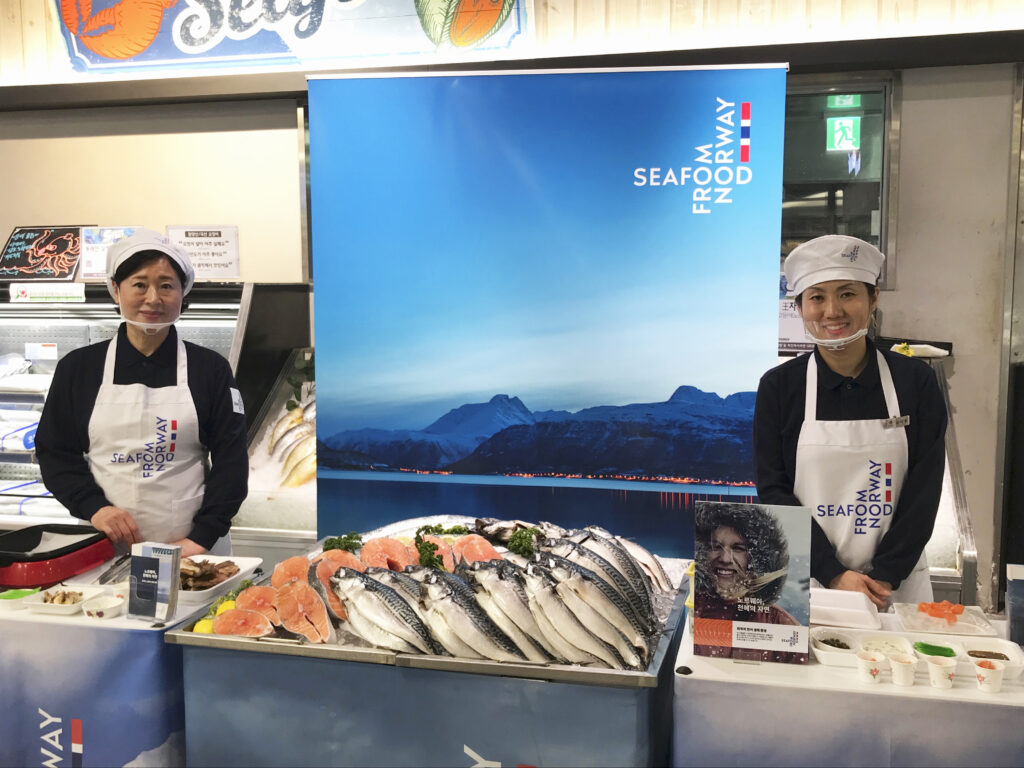Flying the flag

Spain and South Korea will be the main targets next year as the Norwegian Seafood Council unveils another massive marketing budget.
The organisation has set aside just over NOK 300m – around £25m – giving rival salmon producers such as Scotland and the Faroe Islands a lot to think about.
The budget is similar to this year’s spend. It covers all types of seafood, of course, but by far the largest amount, NOK 143m (£12m), will be devoted to promoting farmed salmon mostly through PR and advertising campaigns.
Whitefish such as cod and haddock, much of which goes to the UK, receives NOK 67.5m (almost £5.8m), while NOK 19m £1.6m) will be spent on shellfish and NOK 32.5m (£2.8m) on mackerel and herring.
Covering at least 30 countries, the Seafood Council is determined to get the “Buy Norwegian” message to as many parts of the world as possible. But the budget winners in 2022 will be Spain at NOK 28.5m (£2.37m) and South Korea at NOK 32m (£2.6m). Cod will be pushed hard in Spain while salmon will be the focus in Korea, where demand has been rising.
Around NOK 22.5m (£1.9m) will be spent in France, but with Japan at NOK 19.5m (£1.7m)and China at NOK 17m (£1.48m) these two countries have dropped down the list.
Børge Grønbech, Global Operations Director at the council, says: “Every year, our goal is to have the marketing plans ready by the beginning of October so that the exporters can use them in their own marketing work. We expect to make some adjustments, but, with a few exceptions, most things are now in place.”
The Seafood Council is clearly spreading its net wide with emerging markets such as Israel, the Middle East and Vietnam seeing their currentcombined budgets of NOK 6.3m double to NOK 12.8m (£1.08m) for next year.
Grønbech says: “We have already reorganised with a new Nordic team and relaunched the [inspirational recipe] website Godfisk.no.”
An important focus for the team’s campaign work going forward will be to work closely with the industry and contribute to more Norwegians, especially the slightly younger guard, eating more seafood. It will be marked with, among other things, a “push” on TV campaigns, digital advertising and social media as well as a number of PR activities.
Grønbech is linking the scheme with a business initiative where the council has set aside NOK 26m (£2.2m) in next year’s budget.
This corporate initiative is a co-financing between the Seafood Council and individual companies that, on their own initiative, have plans for new projects.
Some time ago, the salmon sector noticed increasing demand from southern Europe so these markets have received extra funding for the all-important 2021 autumn campaign, which runs up to Christmas.
Grønbech reveals: “One of the largest advertising campaigns of all time for Norwegian salmon is currently being rolled out in Spain, France and Italy.
“Rarely have we run such a high-pressure (effort) in Southern Europe in one and the same period. A total of NOK 64m (£5.3m), over 40% of this year’s total international salmon budget, is going to be spent on major investment in these three countries.”
It was originally planned that Spain should receive the lion’s share, but Italians are taking to salmon in a big way and sales are on the increase in France, so it was decided they should also share the pot.
“An overall goal of the investments is to secure market positions in these important countries, as well as to maintain the increased domestic consumption of salmon we have seen during the pandemic,” Grønbech adds.
He continues: “Both France, Spain and Italy are important engines for Norwegian salmon exports into Europe.
“These are the main reasons why precisely these countries have received extra funds to run large, nationwide campaigns this year.
“By 2020, the three southern European countries accounted for almost a third of all European salmon consumption. France is one of Norway’s largest export markets for salmon, while exports to Spain and Italy have increased sharply in the last 10 years. The potential for further growth is significant.”
The situation is quite different from 2020, when coronavirus hit these countries hard and sales initially plummeted.
But Spanish and French households turned to eating seafood at home in a big way, partly compensating for some of the losses.
Speaking before the renewed toughening of restrictions in Austria, Germany and the Netherlands, Grønbech said the increase in home consumption during the pandemic had continued, but with the added bonus of people now venturing out to restaurants again.
He stressed: “It is important to ensure that post corona trend continues. In France, for example, this year’s advertising campaign contained a strong focus on eating situations and food enjoyment whenever salmon is on the menu.
“This (French) investment provided value for money, and contributed to increased home consumption and an increased reputation for Norwegian salmon.”
Trine Horne, who is the Seafood Council’s Paris-based French envoy, said she had taken lessons learned from last year, including a greater focus on inspiration for recipes and food enjoyment, which included a number of events aimed at chefs and influencers.”
She said this was providing an exciting campaign, with plenty of salmon on the menu, in the run-up to Christmas.

Stand promoting Norwegian salmon, South Korea

